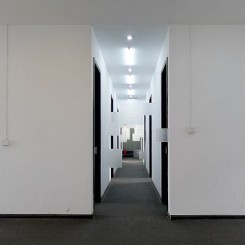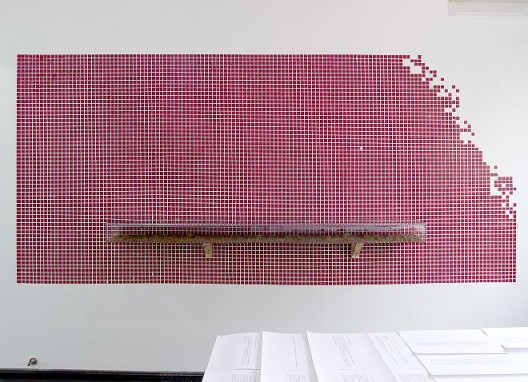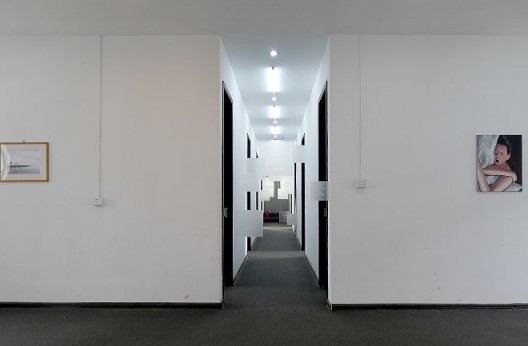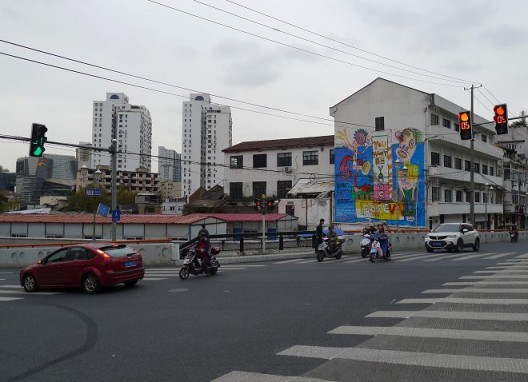“You won’t be young forever”, No.235 Guang Fu Road, Shanghai, China ( Near Wu Zhen Road Bridge) 2016.11.11-2016.12.10
The most fascinating thing about Milorad Pavić’s 1984 novel Dictionary of the Khazars is that regardless of their cultural background, every reader ends up asking the question—where did the Khazars go? Those with a deeper contextual understanding may arrive at the more astute question: is this a metaphor for Serbia? For an excellent author, it is obviously of utmost importance to inspire questions. How, then, should an art curator, as the “author” of an exhibition, raise questions under the labyrinthine conditions of present society?
The group exhibition “You won’t be young forever” curated by Biljana Ciric last November during the Shanghai Biennale did not yield any surprises. She has always insisted on institutional critique as her modus operandi, and now a new batch of artists who haven’t yet entered the mainstream has appeared. The exhibition was presented in a raw and original fashion with emphasis on self-governance, exchange, and experimental collaborative approaches: the artists were asked to handle all exhibition-related matters on their own, including the catalogue. The show was in some ways conversant with and a continuation of the “Mommy Project”, a program Ciric initiated in 2009; “You won’t be young forever” also entailed responses to the reception of the “Mommy Project” at the time.
Yet undeniably this exhibition resembled more of a mid-term report from a long-term fieldwork research project; the presentation of the artworks felt loose and random due to a lack of integration and in-depth exploration. What came across superficially as diverse and accurate was in fact repetitive and non-diverse. With her long-term, fieldwork style of working, Ciric seems to neglect one point: contemporary Chinese society has levels of complexity, contradiction, and diversity that have never been seen before. The three are no longer distinct from each other, but are very much intertwined. The contemporary artistic ecology has undergone many changes and is no longer as homogeneous and deficient as it was ten years ago. Close exchange between cultures and disciplines (as was evident in many artworks related to performance, drama, science, and especially philosophy, sociology and anthropology presented in the “Theory Opera” section of the Shanghai Biennale), the significant emergence of media art, internet art, and bio-art, among others, and the re-establishment of the rights of capital on an overall societal level have challenged the traditional understanding of “core” and “periphery” (in terms of the historic bifurcation of official and unofficial art) . The contemporary situation has made us admit that in the process of eliminating, reconstructing, and re-abolishing different borders, there have been continuous contingencies and new variables, causing art to surpass its original boundaries and forcefully disrupt existing institutional discourses. Today’s art system is no longer in a state of simple opposition, but has come to be characterized by mutual permeation.
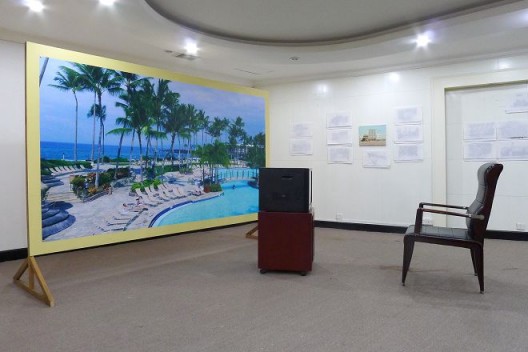
朱建林,《成就》,装置,《好景不常在》展览现场,2016(鸣谢:艺术家和比利安娜)/
Zhu Jianlin, “Achievement Project”, Site Specifc installation, “You won’t be young forever” exhibition view, October 2016
It is precisely amid this process of expanding boundaries that artists have achieved an unprecedented breakthrough in their ability to organize themselves thanks to prolonged negotiations with or oppression by institutions, systems, and capitalism. They have set up non-profit spaces, compiled publications, organized exhibitions, and even used social media platforms—basically every means possible—to spread their thoughts and ideas. So far, it has been active and quite effective. Examples include Arrow Factory and Telescope in Beijing, Yangtze River Space in Wuhan, Observation Society and HB Station in Guangzhou, am art space and Radical Space in Shanghai, and so on. One participating Guangzhou artist in Ciric’s show, Lin Aojie, is a typical example: from his earliest collaboration with other artists, Double Color Balls Group, to his participation in Observation Society to establishing Canton Gallery last year with others including Hu Xiangqian and his works in “You won’t be young forever”, “Good Friend” and “An Ideal Art Institution”, Lin has always been inspired by personal experiences and everyday life; his work expresses humorous insights into life and art, power and institutions. Other works, like Fung Waiging’s Fongfo Monthly (a periodical) and Zhu Jianlin’s “Cheng Jiu”, have also brought active and lively local contexts to us on a micro level; Tang Chao, who has grown much along with Radical Space, presents some “local photography” worth attention, a project that connects his own images with the work of local police to create a new smooth space (in the Deleuzian sense).
The non-profit spaces mentioned above and some of the works in “You won’t be young forever” embody how contemporary artistic production has been influenced by the philosophical ideas of Deleuze and Guattari. The importance of “nomadology” lies in its ultimately deconstructivist critique of the three major constituents of modern politics—power, subjectivity, and rationality—and in the way it can point out problems and provide solutions to social changes and situations. In his irrational, compelling and after all romantic theory, Deleuze presents a strong spirit that is anti-core, anti-whole, anti-organ and anti-authority; here, a conventional “arboreal” mode of thinking has been replaced by extremely creative “rhizomic” thinking, and artists have, one after another, adopted new “lines of flight” (in the words of Deleuze and Guattari) to escape omnipresent codes, expanding their practices in a netlike manner that extends in all directions. Nomadology, along with related concepts such as minority, rhizome, smooth space, and identity politics, has deconstructed the logic and order of grand narratives with rule-less, center-less, open, and accidental nature. This has stimulated artists, through their own work and parallel activities of deconstruction and construction, to produce work that focus on the microscopic everyday.
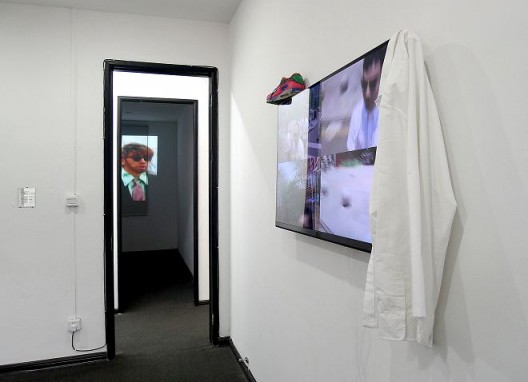
刘野夫,《小拉尔夫》,视频,2015,(左);《浮点》,单通道高清视频装置,2015,(右)
/ Liu Yefu, “ralph rockefeller jr”, video, 2015 (left); “floating point”, single channel hd video installation, color, sound, 2015(right)
For audiences in Southeast Asia, China, and especially Shanghai, Ciric’s distinctiveness is evident because she was once a typical “minoritarian.” With her long-term view and an independent stance carried through her curatorial practice and the perspective of the “other”, she has provided what was once a homogenous and deficient artistic environment with ways to open up new channels in a timely fashion. Her impressive curatorial projects on performance and on-site actions have challenged the existing order and constructed a whole new type of experience in the sense of looking at and participating in art. For example, her recent exhibition “Proposals to Surrender” at Ming Contemporary Art Museum again refreshed viewers’ perception of the “body,” “presence,” and “time.” Her 2013 exhibition “One Step Forward, Two Steps Back”, a collaboration with Guangdong Times Museum, also left viewers with strong impressions of her mode of working and the dimensions of her perspective. Therefore, it is exactly these kinds of obvious “differences” that have become Ciric’s “lines of flight,” which successfully permeate these institutional systems. However, such becoming is not once and for all. What Deleuze proposes is a kind of difference in itself, in which “becoming” means becoming different. Thus, becoming-minoritarian would be the new passage to true diversity. Ciric should hold firmly to her “minor” politics and form a natural, organic symbiotic relationship to the Chinese contemporary art ecology—a form of “double becoming.”
Positioning herself as a cultural “other,” Ciric has long focused on the study of contemporary artistic development in East Asia under the banner of institutional critique that she emphasizes and persists with. However, she will face enormous challenges if she remains content with being an “ambassador” (which, of course, a curator could be) and continues to appropriate and critically reauthorize the external Eurocentric discourse without coming up with creative curatorial concepts and actions to participate in the more recent artistic and theoretical developments. In fact, the urgency of linkage and becoming in contemporary art’s search for transformation is far greater than its urge for simple exchange and representation. For third-world cultural observer-researchers, if one is confined to pure institutional critique, one risks falling into a trap that the renowned Cuban curator Gerardo Mosquera once described in these terms: “critique of the contemporary art system itself will only give impetus to the authorization of the system.” In this way, the curator her/himself might simply become a power component in relation to how the art system functions.
In their brilliant analysis of schizophrenia, Deleuze and Guattari give the following advice: “Find your black holes and white walls, know them, know your faces; it is the only way you will be able to dismantle them and draw your lines of flight.” May this be dedicated to all the participating artists and to the curator Biljana Ciric.
———
Ann is an art curator and critic. Her research is focuses on cultural studies and art criticism. She lives and works in Shanghai.

